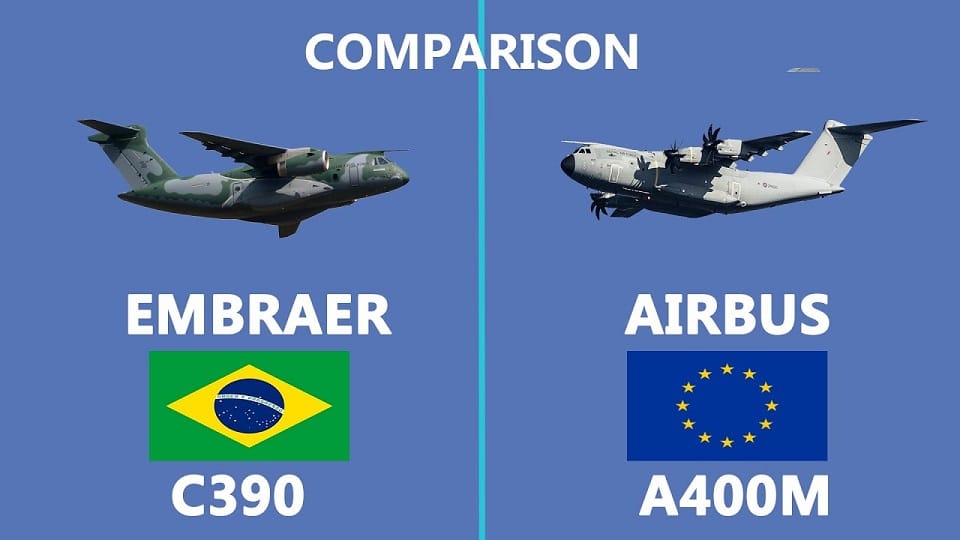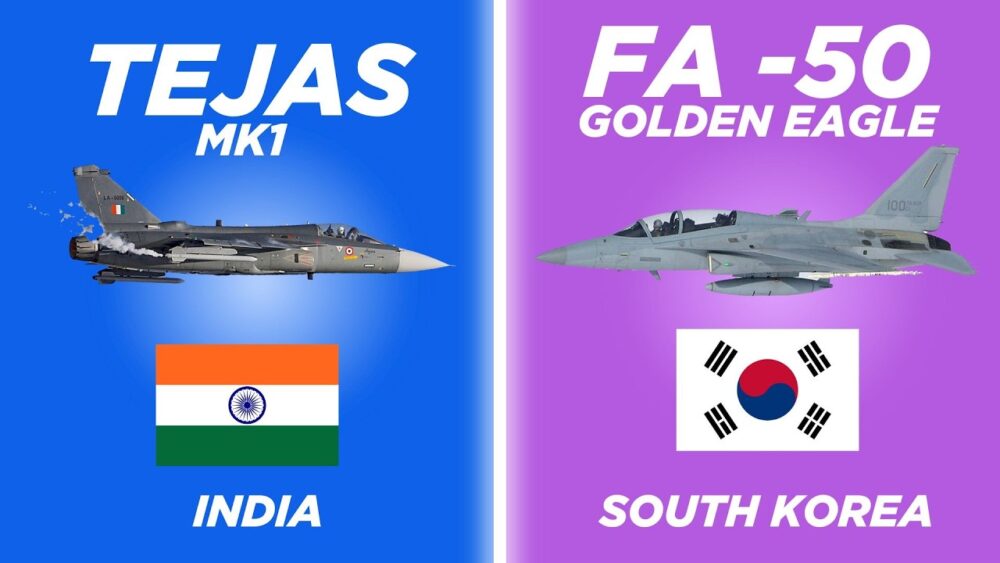Aircraft comparison
Comparison Between Embraer Kc-390 and Airbus A400M

In the following article, we will examine The Embraer KC 390 and the Airbus A400m are the two military aircraft models. Both serve the Military Transportation needs as well as a number of other uses for which the clients employ them. Let’s examine how the two aircraft differ from one another within its class.
Embraer KC-390
The Embraer KC-390 is a twin-engine, medium-size military transport aircraft developed and manufactured by Brazilian aerospace company Embraer. It is designed to perform a variety of missions, including cargo and troop transport, aerial refueling, search and rescue, and medical evacuation.
The aircraft Kc-390 can carry up to 26 tons of cargo, or up to 80 troops, and has a maximum range of 3,400 nautical miles (6,300 kilometers). The KC-390 made its first flight in 2015, and the Brazilian Air Force has ordered 28 aircraft.
The aircraft has been offered for export and has been ordered by Argentina, Portugal, the Czech Republic, and Columbia. How much does the KC 390 cost? By 2013, the KC-390 program had cost US$2.25 billion to develop, and the unit cost is expected to be US$50 million when production begins. This aircraft was first publicly revealed in 2014.
The cargo area of the KC-390 was 35.2 m (115 ft ) in length,11.84 m (38 ft ) in height ahead of the wing. A unique feature was a retractable pressure bulkhead that sealed the cargo cabin and retracted garage door-style into the roof. The KC-90 could transport 74 litters with attendants, 66 paratroopers, or up to 88 fully equipped troops.
Airbus A400M
The Airbus A400M Atlas is a military transport aircraft developed and manufactured by Airbus Defence and Space. It is designed to perform a variety of missions, including strategic and tactical airlift, aerial refueling, and medical evacuation. The A400M can fly to a maximum of 4,100 NM, although this reduces to 2,000 NM with its maximum 37 tonnes of payload. It is equipped with four turboprop engines and advanced avionics, including fly-by-wire technology. The A400M made its first flight in 2009, and it has been ordered by several countries, including Belgium, France, Germany, Spain, Turkey and the United Kingdom.
The aircraft has been delivered to multiple countries and used in various operations and exercises. Can the A400M carry a tank? With a basic fuel capacity of 63,500 liters (50,800 kg), which can be even further increased with additional cargo hold tanks, the A400M is the most capable tactical tanker on the market.
In addition to the ramp, the cargo bay measured 17.71 meters (58 feet) long, 4 meters (13 feet) broad, and 3.85 meters height (12 feet). The cargo bay could be equipped for carrying cargo, moving vehicles, moving troops, or evacuating patients. It could fit up to 20 one-tonne containers or pallets, nine regular pallets with 58 soldiers sitting in fold-down seats along the fuselage’s walls, 120 fully armed soldiers, 116 paratroopers, and 66 stretchers with 25 medical workers.
The Embraer KC-390 and the Airbus A400M are both military transport aircraft designed for a variety of missions, including cargo and troop transport, aerial refueling, search and rescue, and medical evacuation.
However, there are some key differences between the two aircraft:
- Manufacturer: The Embraer KC-390 is manufactured by Brazilian aerospace company Embraer, while the Airbus A400M is manufactured by Airbus Defence and Space.
- Size: The Embraer KC-390 is a medium-sized military transport aircraft, while the Airbus A400M is a larger aircraft.
- Engines: The Embraer KC-390 is powered by two International Aero Engines V2500-E5 turbofan engines, while the Airbus A400M is powered by four Europrop International TP400-D6 turboprop engines.
- Maximum Cargo Capacity: The Embraer KC-390 has a maximum cargo capacity of 26 tons, while the Airbus A400M has a maximum cargo capacity of 37 tons.
- Maximum Passenger Capacity: The Embraer KC-390 can carry up to 80 troops, while the Airbus A400M can carry up to 116 troops.
- Maximum Range: Kc-390 aircraft have a maximum range of around 3,400 nautical miles (6,300 kilometers).while Airbus A400M has 4,100 NM, although this reduces to 2,000 NM with its maximum 37 tonnes of payload.
- First Flight: The Embraer KC-390 made its first flight in 2015, while the Airbus A400M made its first flight in 2009.
- Avionics: Both aircraft are equipped with advanced avionics, including fly-by-wire technology.
- Operators: The Embraer KC-390 is operated by the Brazilian Air Force and other countries, while the Airbus A400M is operated by several countries, including Belgium, France, Germany, Spain, Turkey, and the United Kingdom.Overall, both aircraft are highly capable military transports, but the A400M is larger, can carry more cargo and passengers, and has been in service for a longer period of time.

Aircraft comparison
Comparison of the Indian built Tejas MK1A vs South korean FA 50

Today, we’ll explore two remarkable light combat aircraft: the Tejas MK1A and the FA-50 Golden Eagle. Both fighters are designed for versatility, making them ideal for various missions, from air-to-air combat to ground support.
The Tejas MK1A, developed by Hindustan Aeronautics Limited (HAL) in India, and the FA-50, a product of Korea Aerospace Industries (KAI), are both advanced aircraft equipped with modern technology and features.
10 Fascinating Facts About India’s AMCA Fighter Jet
In this Article, we will compare these two fighters in terms of their specifications, performance, capabilities, and roles in modern air forces. Let’s dive in and see how they stack up against each other!
Tejas is the second supersonic combat aircraft developed by Hindustan Aeronautics Limited (HAL), following the HF-24 Marut. It took its first flight in 2001 and was inducted into service with the Indian Air Force (IAF) in 2015. Currently, Tejas holds the distinction of being the smallest and lightest aircraft in its class of supersonic combat jets.
On the other hand, the FA-50 is South Korea’s first indigenous supersonic aircraft and is one of the few supersonic trainers in the world. Development of the T-50 began in the late 1990s, with its maiden flight taking place in 2002.
Russia Seeks Talks with India, Offers Tu-160 Bombers at Unbeatable Prices
The FA-50 boasts a higher production rate compared to the Tejas. Over the past 15 years, Korea Aerospace Industries (KAI) has produced nearly 200 variants of the FA-50, while Tejas has seen a lower production output.
In terms of international sales, the FA-50 is actively in service with multiple countries, including Indonesia, Iraq, the Philippines, Thailand, and Poland. Notably, Malaysia opted for the FA-50 over the Tejas, citing the FA-50’s strong service record as a key factor in their decision.
Here’s a SPECIFICATION of the Tejas and FA-50
Length: The Tejas measures 13.2 m (43 ft 4 in), making it slightly longer than the FA-50, which is 13.14 m (43 ft 1 in).
Max Takeoff Weight: The Tejas has a maximum takeoff weight of 13,500 kg (29,762 lb), compared to the FA-50’s lighter weight of 10,722 kg (23,638 lb).
Fuel Capacity: The Tejas has an internal fuel capacity of 3,060 liters (810 US gallons), while the FA-50 has a slightly lower internal fuel capacity of 2,655 liters (701 US gallons).
Powerplant: Both aircraft are powered by General Electric F404 turbofan engines, but the Tejas utilizes the F404-GE-IN20 variant with 48.9 kN (11,000 lbf) thrust dry and 85 kN (19,000 lbf) with afterburner. The FA-50 features the F404-GE-102 variant, producing 53.07 kN (11,930 lbf) thrust dry and 78.7 kN (17,700 lbf) with afterburner.
Maximum Speed: The Tejas has a maximum speed of 2,220 km/h (Mach 1.8), which is significantly faster than the FA-50’s maximum speed of 1,837.5 km/h (Mach 1.5).
Combat Range: The Tejas has a combat range of 739 km (459 mi), whereas the FA-50 has a much longer range of 1,851 km (1,150 mi).
Hardpoints: The Tejas features 9 hardpoints with a total capacity of 5,300 kg, while the FA-50 has 7 hardpoints capable of carrying up to 5,400 kg of payload.
Cost: The Tejas is priced at approximately $40 million per unit, whereas the FA-50 ranges between $30 million to $40 million per unit, making the FA-50 potentially more cost-effective depending on the variant chosen.
Weapons
When it comes to weaponry, the Tejas MK1A offers a wider range of options compared to the FA-50 Golden Eagle. The Tejas MK1A is equipped with beyond-visual-range (BVR) missiles, allowing it to engage targets at greater distances, enhancing its combat effectiveness in air superiority missions. Additionally, it can carry precision-guided munitions for accurate strikes against ground targets, as well as standoff weapons, which can be launched from a distance to minimize exposure to enemy defenses. This diverse armament enables the Tejas to perform a variety of roles, from air-to-air combat to ground support.
In contrast, the FA-50 also features a respectable armament capability but has a more limited selection. It can carry air-to-air missiles like the AIM-9 Sidewinder and AIM-120 AMRAAM, as well as precision-guided bombs. However, its focus leans more toward close air support and light strike missions rather than the extensive versatility that the Tejas offers.
Naval Variant
The Tejas Mk1A has a naval variant designed for carrier operations, which is still in development. This version includes upgrades like a nose droop for better visibility during landings and takeoffs, a strengthened undercarriage, and an arrestor hook for safe landings on aircraft carriers.
In contrast, the FA-50 does not have a naval variant. While it’s versatile for different missions, it’s not designed for carrier operations, limiting its flexibility compared to the naval Tejas, which can operate from both land and carriers.
-

 Aviation2 months ago
Aviation2 months agoBoeing confirms 797: A New Era for Mid-Size Aircraft
-

 Aviation2 months ago
Aviation2 months agoMicrosoft Flight Simulator Raises $3 Million to Bring Back the An-225 Mriya
-

 Aviation2 months ago
Aviation2 months agoLockheed and Tata Team Up to Build C-130J MRO Facility in India
-

 Airlines2 months ago
Airlines2 months agoQantas Engineers Stage Walkout Over Cost of Living Concerns
-

 Airlines2 months ago
Airlines2 months agoQatar Citizens Can Travel to the United States Without a Visa
-

 Aviation2 months ago
Aviation2 months agoBoeing Offers 25% Pay Increase & Promise to Build Next Plane in Seattle
-

 Aviation2 months ago
Aviation2 months agoQatar Airways bans these new Electronic Devices on plane
-

 Airlines2 months ago
Airlines2 months agoEmirates Ends 28-Year Singapore-Melbourne Fifth Freedom Route








